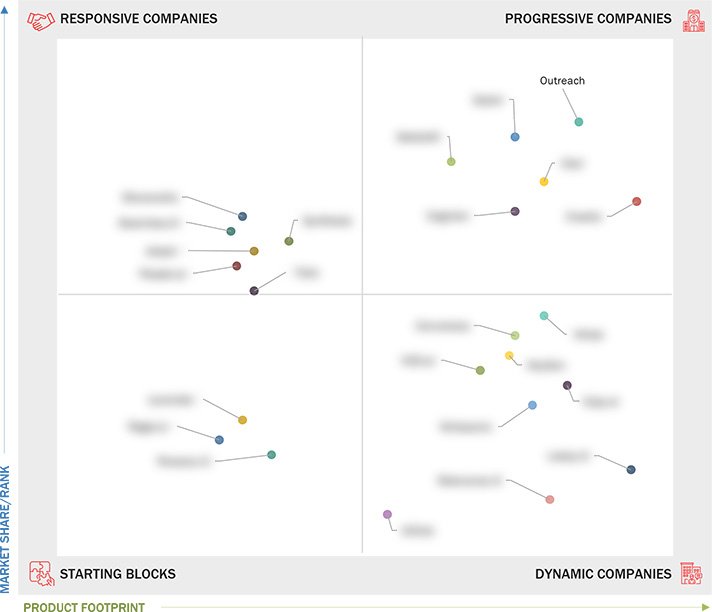Comparing 24 vendors in AI for Sales and Marketing Startups across 0 criteria.
The AI for Sales and Marketing sector is witnessing a profound transformation driven by the rapid adoption of AI technologies across various industries. Much of this change is propelled by the growing need for businesses to enhance their marketing strategies and streamline sales processes to stay competitive in a digital-first world.
Market Leadership Quadrant
1.1 Study Objectives
1.2 Market Definition
1.3 Market Scope
1.3.1 Market Segmentation
1.3.2 Inclusions and Exclusions
1.3.3 Years Considered
1.4 Currency Considered
1.5 Stakeholders
2.1 Introduction
2.2 Market Dynamics
2.2.1 Drivers
2.2.1.1 Development of explainable AI models allows sales teams to
understand and articulate need for specific recommendations
2.2.1.2 Emergence of privacy-preserving machine learning techniques
enabled marketers to extract insights from customer data
while maintaining compliance
2.2.1.3 Evolution of real-time processing capabilities allowed AI
systems to analyze and respond to customer interactions
instantly
2.2.2 Restraints
2.2.2.1 AI struggles to interpret complex human emotions and nuanced
buyer intent despite advances in sentiment analysis
2.2.2.2 AI-generated sales outreach often lacks authenticity needed
for high-conversion engagement
2.2.2.3 Shortage of marketing professionals who understand AI
capabilities and marketing principles to create knowledge
gap
2.2.3 Opportunities
2.2.3.1 Convergence of augmented reality and AI to create
opportunities for immersive product demonstrations adapting
to individual customer preferences
2.2.3.2 Multimodal AI models open new possibilities for creating
dynamic video content that adapts in real time to viewer
engagement metrics
2.2.3.3 Integration of quantum computing with AI marketing systems
to enable real-time optimization of complex, multi-channel
campaigns
2.2.4 Challenges
2.2.4.1 Rise of synthetic data and AI-generated personas to affect
distinction between genuine customer behavior and artificial
interactions
2.2.4.2 AI struggles to generate truly personalized marketing
content that resonates with diverse audiences
2.2.4.3 AI-driven lead scoring systems often misinterpret buyer
intent, leading to inaccurate prioritization
2.3 Evolution of AI for Sales & Marketing
2.4 Supply Chain Analysis
2.5 Ecosystem Analysis
2.5.1 AI Sales Software Type
2.5.1.1 Email generators
2.5.1.2 Chatbots & assistants
2.5.1.3 Sales agents
2.5.1.4 Sales forecasting
2.5.1.5 Lead scoring
2.5.1.6 Sales intelligence
2.5.1.7 Customer relationship management (CRM)
2.5.1.8 Sales coach
2.5.1.9 Revenue intelligence
2.5.1.10 Personalized outreach
2.5.1.11 Pipeline management
2.5.2 AI Marketing Software Type
2.5.2.1 Campaign management
2.5.2.2 SEO optimization
2.5.2.3 Advertising
2.5.2.4 Digital marketing
2.5.2.5 Content creation
2.5.2.6 Social media management
2.5.2.7 Marketing agents
2.5.2.8 Customer data platform (CDP)
2.5.2.9 Conversational marketing
2.5.2.10 Email marketing
2.5.2.11 Influencer marketing
2.6 Investment Landscape and Funding Scenario
2.7 Impact of Generative AI on Sales & Marketing Market
2.7.1 Personalized Content Generation
2.7.2 Chatbots and Virtual Assistants
2.7.3 Ad and Creative Design Generation
2.7.4 Sales Coaching and Enablement
2.7.5 Market Research and Trend Analysis
2.7.6 Lead Scoring and Prospecting
2.8 Technology Analysis
2.8.1 Key Technologies
2.8.1.1 Conversational AI
2.8.1.2 Robotic process automation (RPA)
2.8.1.3 Autonomous AI and autonomous agents
2.8.1.4 AutoML
2.8.1.5 Computer vision
2.8.1.6 Decision intelligence
2.8.2 Complementary Technologies
2.8.2.1 Internet of Things (IoT)
2.8.2.2 Casual AI
2.8.2.3 Big data
2.8.2.4 AR/VR
2.8.3 Adjacent Technologies
2.8.3.1 Blockchain
2.8.3.2 Edge computing
2.8.3.3 Cybersecurity
2.9 Patent Analysis
2.9.1 Methodology
2.9.2 Patents Filed, By Document Type
2.9.3 Innovation and Patent Applications
2.10 Key Conferences and Events
2.11 Porter’s Five Forces Analysis
2.11.1 Threat of New Entrants
2.11.2 Threat of Substitutes
2.11.3 Bargaining Power of Suppliers
2.11.4 Bargaining Power of Buyers
2.11.5 Intensity of Competition Rivalry
2.12 Trends/Disruptions Impacting Customers’ Businesses
2.12.1 Trends/Disruptions Impacting Customers’ Businesses
3.1 Overview
3.2 Key Player Strategies/Right to Win, 2022–2025
3.3 Revenue Analysis, 2020–2024
3.4 Market Share Analysis, 2024
3.5 Product Comparative Analysis
3.5.1 Product Comparative Analysis, By Prominent/Leading Vendor
3.5.1.1 Salesforce Einstein AI and Pardot (Salesforce)
3.5.1.2 Google Cloud AI and Google Ads (Google)
3.5.1.3 Adobe Sensei and Marketo (Adobe)
3.5.1.4 Microsoft Dynamics 365 and Microsoft AI (Microsoft)
3.5.1.5 Oracle Eloqua and Oracle AI for Customer Experience (IBM)
3.5.2 Product Comparative Analysis, By Prominent Startup/SME Vendor
3.5.2.1 Outreach Platform (Outreach)
3.5.2.2 Cognism Prospector (Cognism)
3.5.2.3 People.ai Platform (People.ai)
3.5.2.4 Salesloft Platform (Salesloft)
3.5.2.5 Clari Revenue Platform (Clari)
3.6 Company Valuation and Financial Metrics
3.7 Company Evaluation Matrix: Startups/SMEs, 2024
3.7.1 Progressive Companies
3.7.2 Responsive Companies
3.7.3 Dynamic Companies
3.7.4 Starting Blocks
3.7.5 Competitive Benchmarking: Startups/SMEs, 2024
3.7.5.1 Detailed list of key startups/SMEs
3.7.5.2 Competitive benchmarking of key startups/SMEs (application)
3.7.5.3 Competitive benchmarking of key startups/SMEs (end user and region)
3.8 Competitive Scenario and Trends
3.8.1 Product Launches and Enhancements
3.8.2 Deals
4.1 AICHAT
4.1.1 Business overview
4.1.2 Products/Solutions/Services offered
4.1.3 Recent developments
4.2 PEOPLE.AI
4.2.1 Business overview
4.2.2 Products/Solutions/Services offered
4.2.3 Recent developments
4.3 COPY.AI
4.3.1 Business overview
4.3.2 Products/Solutions/Services offered
4.3.3 Recent developments
4.4 MOVEWORKS
4.4.1 Business overview
4.4.2 Products/Solutions/Services offered
4.4.3 Recent developments
4.5 OUTREACH
4.5.1 Business overview
4.5.2 Products/Solutions/Services offered
4.5.3 Recent developments
4.6 H20.AI
4.6.1 Business overview
4.6.2 Products/Solutions/Services offered
4.6.3 Recent developments
4.7 SYNTHESIA
4.7.1 Business overview
4.7.2 Products/Solutions/Services offered
4.7.3 Recent developments
4.8 JASPER
4.8.1 Business overview
4.8.2 Products/Solutions/Services offered
4.8.3 Recent developments
4.9 WRITESONIC
4.9.1 Business overview
4.9.2 Products/Solutions/Services offered
4.9.3 Recent developments
4.10 SALESLOFT
4.10.1 Business overview
4.10.2 Products/Solutions/Services offered
4.10.3 Recent developments
4.11 ZAPIER
4.11.1 Business overview
4.11.2 Products/Solutions/Services offered
4.11.3 Recent developments
4.12 HEYGEN
4.12.1 Business overview
4.12.2 Products/Solutions/Services offered
4.12.3 Recent developments
4.13 CONVERSICA
4.13.1 Business overview
4.13.2 Products/Solutions/Services offered
4.13.3 Recent developments
4.14 RELEVANCE AI
4.14.1 Business overview
4.14.2 Products/Solutions/Services offered
4.14.3 Recent developments
4.15 VELOXY
4.15.1 Business overview
4.15.2 Products/Solutions/Services offered
4.15.3 Recent developments
4.16 COGNISM
4.16.1 Business overview
4.16.2 Products/Solutions/Services offered
4.16.3 Recent developments
4.17 LAVENDER
4.17.1 Business overview
4.17.2 Products/Solutions/Services offered
4.17.3 Recent developments
4.18 CLARI
4.18.1 Business overview
4.18.2 Products/Solutions/Services offered
4.18.3 Recent developments
4.19 TIDIO
4.19.1 Business overview
4.19.2 Products/Solutions/Services offered
4.19.3 Recent developments
4.20 WRITER
4.20.1 Business overview
4.20.2 Products/Solutions/Services offered
4.20.3 Recent developments
4.21 SEAMLESS.AI
4.21.1 Business overview
4.21.2 Products/Solutions/Services offered
4.21.3 Recent developments
4.22 CREATIO
4.22.1 Business overview
4.22.2 Products/Solutions/Services offered
4.22.3 Recent developments
4.23 LATELY.AI
4.23.1 Business overview
4.23.2 Products/Solutions/Services offered
4.23.3 Recent developments
4.24 REGIE.AI
4.24.1 Business overview
4.24.2 Products/Solutions/Services offered
4.24.3 Recent developments


 businesswire
businesswire
 Jan 2025
Jan 2025

